Understanding LASIK. Easing the Fear of the Unknown
The fear of the unknown can be intimidating if you are considering LASIK and unsure of how does LASIK work. If you don’t know exactly what to expect or how LASIK works, you might be hesitant about going through with the procedure, and understandably so. To help you understand LASIK and ease those fears, we’ll take a detailed look at understanding LASIK and explain each step so you understand the procedure and how LASIK surgery is done. After all, knowing the crucial LASIK surgery facts is half the battle!
To find out if you are a candidate for LASIK, schedule your FREE* exam with Dr. Charles Manger, the OC’s LASIK expertSM.
What is LASIK?

LASIK is the most common refractive vision correction procedure performed today and nearly 20 million LASIK procedures have been performed worldwide.1,2 The complication rate for LASIK is also extremely low. While no surgery comes without risk, experienced LASIK surgeons like Dr. Charles Manger of Saddleback Eye Center report a complication rate well below 1%. You might also be surprised to learn that the risk associated with long-term wear of contact lenses is 5 times higher than the risk of a single LASIK procedure.3
What vision problems can LASIK correct?
When the cornea is misshapen and/or the eyeball is too long or too short, light does not reflect properly on the retina, leaving a person with vision that is blurry or unclear. These issues are known as “refractive errors” and include astigmatism, myopia, and hyperopia. By reshaping the cornea, LASIK is able to change how light is “refracted” or bent as it travels through the eye and can correct most types of these refractive errors.
|
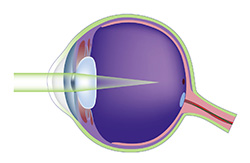 |
|
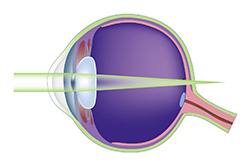 |
|
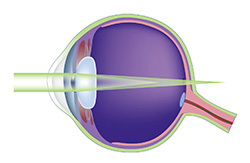 |
Eighty percent of the people who meet the age and health requirements are good candidates for Dr. Manger’s signature LASIKSM vision correction procedure. To find out if Dr. Manger can correct your vision, schedule your FREE* LASIK exam now.
The LASIK Procedure
Step 1: Creating a treatment plan using a detailed map of the cornea
Before beginning understanding LASIK surgery, your surgeon will create a map of the cornea to determine how it will need to be reshaped to correct your vision. This map can be created using different types of equipment, but the most accurate and detailed way to do this is using wavefront laser technology.
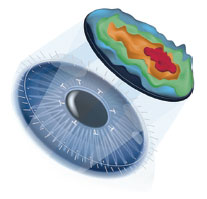
While not every surgeon uses this advanced technology, Dr. Manger uses wavefront laser technology for every single one of his patients as part of the LASIK procedure. In fact, Dr. Manger has 2 wavefront lasers in his practice to ensure that every patient’s custom LASIK procedure begins with this critical step.
What you can expect during Step 1: You will be sitting upright and asked to stare into a machine at a fixation light. This will allow your eyes to focus so an accurate corneal map can be captured.
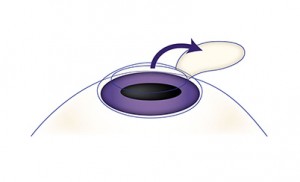
After the detailed map of your cornea has been created, the next step is to create a paper-thin flap in the cornea. This gives your surgeon access to the corneal tissue so it can be reshaped. The flap will remain out of the way throughout the procedure and will be replaced later in Step 4.
The corneal flap can be created in 1 of 2 ways: 1) by using a blade and a holding device called a microkeratome or 2) by using a femtosecond laser. Both ways of creating the flap are effective, but using a laser is safer and more accurate and can result in fewer complications like halos and glare. These issues can be especially troublesome when driving at night.
Figure 1. Corneal flap creation using a microkeratome.
Figure 2. Blade-free corneal flap creation using a femtosecond laser.
When a surgeon uses a laser to create the corneal flap, the LASIK procedure is known as an all-laser or blade-free procedure. At Saddleback Eye Center, Dr. Manger has 2 femtosecond lasers on site and provides his patients with all-laser LASIK as part of his LASIK procedure.
What you can expect during Step 2: You will already have been prepped for the procedure by this time, which includes having numbing drops placed in your eyes and taking a mild sedative, if you choose. This makes the procedure comfortable and pain-free. You will also be lying comfortably on a bed positioned under a laser for this and the remaining steps in the procedure. Each eye will be treated one at a time. Because of the numbing drops, you will not feel any pain but you may feel gentle pressure when the laser is working.
Step 3: Reshaping the cornea
This is the step where your understanding LASIK surgeon will correct your vision using an excimer laser. The topographical map that was created in Step 1 will be used as a guide for how the laser will reshape the cornea in order to give you your best visual outcome. Remember that not all surgeons use this technology, but Dr. Manger does in order to give his patients a custom procedure and an optimal outcome.
In order to further customize the procedure for each of his patients, Dr. Manger also has the 3 most advanced excimer lasers in his cutting-edge surgery center:
- VISX Star 4 with Iris Registration
- Allegretto WaveLight EX500
- Allegretto Wave Eye-Q400
These lasers have sophisticated eye-tracking devices that trace eye movements up to 1000 times per second. By tracking eye movements, these lasers can ensure that your eye stays centered on the laser, which helps contribute to the quality of your visual outcome. By having three different lasers, Dr. Manger is also able to choose the best laser for your eyes, rather than taking a “one-size-fits-all” approach used by most other LASIK surgeons.
What you can expect during Step 3: Step 3 is very similar to Step 2 and you will remain lying down. You will be asked to focus on a light while your surgeon is performing this step, to center your eye under the laser. The eye-tracking device in the laser will also track any movement your eye may make.
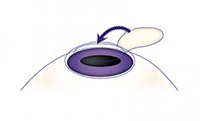
After the cornea has been reshaped, the corneal flap will be placed back over your eye. Because the cornea is able to heal on its own very quickly, no stitches are required. The flap will self-seal within just a few hours. Once the flap has been replaced, your surgeon will provide you with protective eyewear and ask that you keep your eyes closed as much as possible for the next few hours so the flap can heal.
What you can expect during Step 4: You might feel a mild scratchy or sandy feeling in your eyes as the flap heals, but this doesn’t last very long and can be alleviated if you continue to keep your eyes gently closed or sleep.
Step 5: Enjoy your new vision!
After the flap has been replaced, you will begin the short healing process and then be ready to enjoy your clear vision, without glasses or contacts. Most people are back to normal visual activities the very next day, such as driving, working at the computer, and watching TV. When you awaken the day after your procedure, you will be delighted to greet the day with your new vision.
What you can expect during Step 5: A series of eye drops will need to be used following the surgery to prevent infection. Always follow your surgeon’s instructions on how to administer these drops.
Now… Take the Next Step!
Now that you are understanding the LASIK procedure, how it works, and what to expect, schedule your FREE* exam at Saddleback Eye Center to find out if you are a candidate for Dr. Manger’s signature LASIK procedure. Dr. Manger has personally performed more than 75,000 LASIK procedures, giving him personal experience and expertise that very few—if any—LASIK surgeons can match.4 Perhaps that’s why 35% of Orange County patients choose Dr. Manger, out of 64 practicing LASIK surgeons in Orange County!5
Call Saddleback Eye Center today at (949) 951-4641 or schedule your free LASIK exam online!
Understanding LASIK References:
- Lombardo AJ and Lindstrom RL. AAO Clinical Updates: Demographics of Refractive Surgery Patients and Market Trends. Volume 1, Module 5. http://www.aao.org/vp/edu/refract/v1m5/refractive_management_v1m5.pdf. Accessed September 3, 2014.
- Solomon KD, Fernández de Castro LE, Sandoval HP, et al. LASIK World Literature Review: Quality of Life and Patient Satisfaction. Ophthalmology. 2009;116(4):691-701.
- Mathers WD, Fraunfelder FW, Rich LF. Risk of Lasik Surgery vs Contact Lenses. Arch Ophthalmol. 2006;124(10):1510-1511.
- Data on file. Saddleback Eye Center.
- Market Scope United States Refractive Atlas, 2014




